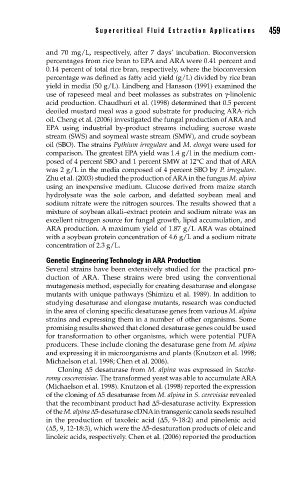Page 487 - Biosystems Engineering
P. 487
Super critical Fluid Extraction Applications 459
and 70 mg/L, respectively, after 7 days’ incubation. Bioconversion
percentages from rice bran to EPA and ARA were 0.41 percent and
0.14 percent of total rice bran, respectively, where the bioconversion
percentage was defined as fatty acid yield (g/L) divided by rice bran
yield in media (50 g/L). Lindberg and Hansson (1991) examined the
use of rapeseed meal and beet molasses as substrates on γ-linolenic
acid production. Chaudhuri et al. (1998) determined that 0.5 percent
deoiled mustard meal was a good substrate for producing ARA-rich
oil. Cheng et al. (2006) investigated the fungal production of ARA and
EPA using industrial by-product streams including sucrose waste
stream (SWS) and soymeal waste stream (SMW), and crude soybean
oil (SBO). The strains Pythium irregulare and M. elonga were used for
comparison. The greatest EPA yield was 1.4 g/l in the medium com-
posed of 4 percent SBO and 1 percent SMW at 12°C and that of ARA
was 2 g/L in the media composed of 4 percent SBO by P. irregulare.
Zhu et al. (2003) studied the production of ARA in the fungus M. alpina
using an inexpensive medium. Glucose derived from maize starch
hydrolysate was the sole carbon, and defatted soybean meal and
sodium nitrate were the nitrogen sources. The results showed that a
mixture of soybean alkali–extract protein and sodium nitrate was an
excellent nitrogen source for fungal growth, lipid accumulation, and
ARA production. A maximum yield of 1.87 g/L ARA was obtained
with a soybean protein concentration of 4.6 g/L and a sodium nitrate
concentration of 2.3 g/L.
Genetic Engineering Technology in ARA Production
Several strains have been extensively studied for the practical pro-
duction of ARA. These strains were bred using the conventional
mutagenesis method, especially for creating desaturase and elongase
mutants with unique pathways (Shimizu et al. 1989). In addition to
studying desaturase and elongase mutants, research was conducted
in the area of cloning specific desaturase genes from various M. alpina
strains and expressing them in a number of other organisms. Some
promising results showed that cloned desaturase genes could be used
for transformation to other organisms, which were potential PUFA
producers. These include cloning the desaturase gene from M. alpina
and expressing it in microorganisms and plants (Knutzon et al. 1998;
Michaelson et al. 1998; Chen et al. 2006).
Cloning Δ5 desaturase from M. alpina was expressed in Saccha-
romy cescerevisiae. The transformed yeast was able to accumulate ARA
(Michaelson et al. 1998). Knutzon et al. (1998) reported the expression
of the cloning of Δ5 desaturase from M. alpina in S. cerevisiae revealed
that the recombinant product had Δ5-desaturase activity. Expression
of the M. alpina Δ5-desaturase cDNA in transgenic canola seeds resulted
in the production of taxoleic acid (Δ5, 9-18:2) and pinolenic acid
(Δ5, 9, 12-18:3), which were the Δ5-desaturation products of oleic and
linoleic acids, respectively. Chen et al. (2006) reported the production

